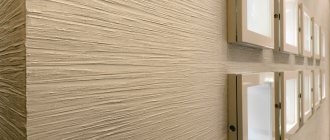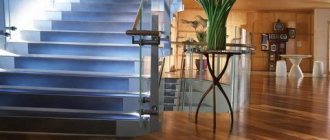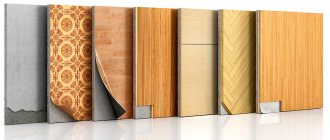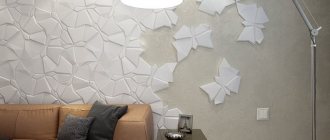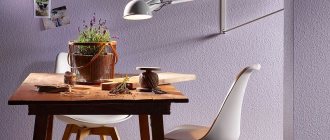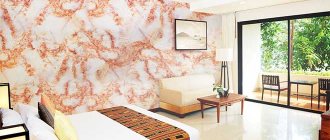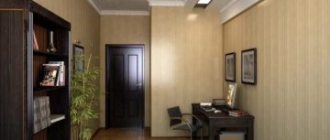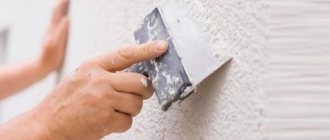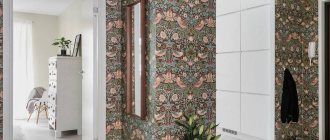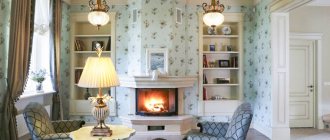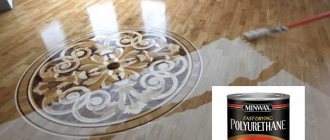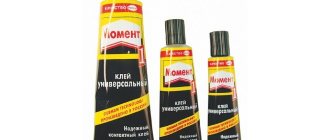Wallpaper
Wallpaper is the most common, commonly used way to decorate walls. For quite a long time, wallpaper in Europe was exclusively made of fabric or leather. Hence the name - they were not glued, but nailed.
Wallpaper today has a diverse range of products to suit all occasions and budgets. Here are paper and textile, vinyl and non-woven, acrylic and fiberglass, wood, cork, metal... Wallpaper in the form of huge photographs and paintings, as well as with 3D images. Moreover, each variety has its own undeniable advantages.
Paper wallpaper
Paper wallpapers are affordable and organic, and an impressive range of colors, textures and patterns opens the way for them to any room. In addition, anyone can handle gluing paper wallpaper, which allows you to save on repairs.
Paper covering is most suitable for the walls of the hallway, living room and bedroom. A variety is glued in the corridor, which, if necessary, can be painted, and the living room is decorated, as a rule, with multi-layered, embossed, primed types of wallpaper. Inexpensive, but “fun” paper wallpaper is also used in the nursery - if the artist in the child awakens, such a finish will be easy to quickly change.
The disadvantages of paper coatings include their fragility and fragility: only the best, multi-layer samples can last 5 years or more without visible loss of quality. And paper does not tolerate moisture well, is highly flammable and fades quite quickly.
Paper wallpaper in the interior, types and design examples
Top ↑
Photo wallpaper
Photo wallpapers became popular in the late 80s of the last century, and have not left homes to this day. This is because their range is truly limitless, the price is not exorbitant, and you can hang such wallpaper yourself. In addition, modern photo wallpapers are highly resistant to fading, repel dust, have an additional protective film and can be produced according to individual orders - for example, with portraits of household members. Actually, these are the advantages of paper photo wallpapers.
The disadvantages include the fact that such wallpaper requires absolutely flat surfaces and, like any paper, is not very durable. The average service life is 3-7 years.
Photo wallpaper in the interior, current options, photos
Top ↑
Fabric wallpaper
Textile wallpapers are linen, felt, silk, velor; on non-woven, paper or synthetic base.
The advantages of fabric upholstery are its naturalness, good thermal insulation, greater resistance to fading compared to paper wallpaper, decent appearance and richness of textures. And also a solid – on average 10 years – service life.
The most environmentally friendly option, paper-based linen upholstery, can be safely recommended for the nursery. Silk wallpaper, as if by magic, will transform an ordinary living room into a chic salon. And felt or velor wallpaper will make the bedroom warmer and more secluded. If more insulation is required, the walls are covered with textile wallpaper on a porous synthetic base: their thickness can reach 5 millimeters. This same variety is least susceptible to deformation. The maximum period of use of such coating is up to 10 years.
Negative qualities of fabric wallpaper: the need for regular cleaning, instability to mechanical stress, relatively high price. In addition, fabric wallpaper requires perfectly flat surfaces, as well as knowledge of the nuances of application to walls.
Textile wallpaper in the interior, advantages and disadvantages, photos
Top ↑
Jute wallpaper
Jute wallpaper belongs to a wide family of design materials with natural plant coverings. They are also called wallpaper mats. They can be based on either paper or non-woven fabric.
Jute wallpaper is valued for its 100% naturalness, breathability, resistance to ultraviolet radiation and mechanical stress. And the characteristic, knotty structure elevates these wallpapers from the category of ordinary coatings to the rank of stylish designer features. Most often, jute is used when they want to emphasize the minimalism, eco or ethnic character of the interior. This type of wallpaper is used primarily for living rooms and bedrooms; However, the safety and hypoallergenic nature of jute makes it a welcome “guest” in children’s rooms.
The disadvantages of jute coverings include their ability to absorb odors (which is why you rarely see jute in kitchens), the need for regular cleaning and a considerable price. The average service life is 10-15 years.
Top ↑
Vinyl wallpapers
Vinyl wallpaper is on the crest of popularity today. Of course, this type of finishing can imitate stone, wood, plaster or, say, suede. It should be noted that vinyl wallpapers are also divided into a considerable number of subtypes: structural, with relief and a layer of foamed vinyl, with hot stamping and silk-screen printing effect.
The strengths of this coating include a high degree of sound insulation, the ability to mask small irregularities and roughness on the walls, and resistance to fading and moisture. Due to the fact that vinyl wallpapers are not afraid of water and steam, they are relevant in kitchens and bathrooms.
But vinyl wallpaper also has its drawbacks: airtightness, difficulty in gluing it yourself, relatively high cost, and also a not very pleasant smell that cheap samples can emit. Service life is on average 20 years.
Top ↑
Non-woven wallpaper
Non-woven wallpaper can be used for paper, fabric or vinyl wallpapers. These are rolls of cellulose fibers bonded with polymers. Their advantages are environmental friendliness, breathability, a wide palette of patterns, and also the ability to repaint these wallpapers and use them to smooth out small bumps and blemishes on the walls. The service life of non-woven wallpaper is about 10 years.
And now about the shortcomings. Firstly, not everyone can afford high-quality non-woven wallpaper. Secondly, dust accumulates in the “folds” of their embossing. They are also quite easy to damage, for example, when rearranging furniture. Finally, the non-woven covering must be glued to exemplarily clean, plain walls. Otherwise, stains and stains may be visible.
Top ↑
Acrylic wallpaper
It is believed that this is an analogue of vinyl coatings, which are based on paper, and foamed vinyl replaces polymer coating. Advantages: hypoallergenic, durable, practical, moisture-resistant, which allows you to use wallpaper in the living room, kitchen, and even the bathroom. And also resistance to mechanical stress and ease of handling. It is not surprising that acrylic wallpaper is preferred by families with playful children or pets.
Disadvantages: such wallpapers are inferior to their vinyl “brothers” in thickness and, therefore, in durability. And their color range is not so diverse. Application period is 10-12 years.
Top ↑
Glass wallpaper
This still non-trivial type of finishing is gaining more and more points - thin, glass yarn rolled into rolls. It consists of dolomite, sand and similar additives, so naturalness and harmlessness are one of the “trump cards” of glass wallpaper.
There are other advantages: high strength, resistance to chemical and mechanical influences, fire and moisture, and the possibility of painting. Fiberglass fabric is so presentable that it often adorns the walls of posh bars and restaurants. Nothing prevents the use of glass wallpaper in any room, but they look especially impressive in classic as well as modern living rooms.
The disadvantages include the complexity of installation and, especially, dismantling, and the requirement for an absolutely flat wall surface. In addition, glass wallpaper, due to the complex production technology, is an expensive pleasure. But the service life of the glass coating is up to 30 years.
Top ↑
Cork wallpaper
The raw material for their production is Mediterranean oak bark with its unique resinous substances. The advantages of the material are obvious: environmental friendliness, bactericidal properties, creation of a special, healing microclimate. Cork also has enviable insulating properties. If someone in an apartment, for example, plays music, the neighbors are unlikely to hear, because the traffic jam will absorb the decibels. It is also important that, unlike wooden coverings, cork does not ignite and does not support combustion. After all, the velvety nature of cork bark is pleasant to the touch, which is why it is used in rooms for very young children.
Among the disadvantages of cork wallpaper, mention should be made of a relatively narrow range of colors. It cannot be said that their patterns are monotonous, but their natural color is in the range of natural wood - from light yellow to dark brown. And it is also worth considering that they will not be cheap, although the high cost in this case is compensated by a rather long service life. Service life – up to 30 years.
Top ↑
Linkrust
It may seem that we are talking about a new product, but this material was invented back in 1877. These are rolls that are formed from wood flour mixed with wax, rosin, and linseed oil. The surface of the linkcrust is embossed and patterned, which gives the finish an expensive, respectable look.
The best qualities of linkrust are environmental safety, commendable thermal stability, durability, resistance to deformation, a wide selection of colors and shades, the ability to paint, and ease of maintenance. The shelf life of linkrust wallpaper is practically unlimited, which can be confirmed by the perfectly preserved interiors of many ancient houses.
Linkrust looks great in a classic, Victorian setting. However, it is also characterized by certain defects - for example, instability at low temperatures, a complex installation process, and high cost.
Magnificent wallpaper: linkrust in the interior, photo
Top ↑
Metallized wallpaper
Metallic/metallic wallpaper can be embossed, blackened, etched, painted, patinated... Thanks to its decorative variety, this type of wall covering is a signature technique of many famous designers.
Wallpaper covered with a layer of foil, namely they are called metal, is resistant to moisture, wear, and has good thermal insulation. Well, if they are of the mirror type, then they also have the ability to visually “spread” the space.
Metallic wallpaper in a noble shade is adored by fans of expensive, pretentious styles such as Empire, Art Deco and Art Nouveau. Designers especially recommend this wallpaper for decorating halls, lobbies and halls.
The disadvantages of this coating are air tightness and low resistance to mechanical stress. Metallic wallpaper also requires perfectly smooth walls... and considerable investment. Their shelf life is on average 10 years.
Top ↑
Liquid wallpaper
Liquid wallpaper, also known as flock and silk plaster. Despite the natural base, after hardening on the walls, this coating bears little resemblance to wallpaper. The advantages of liquid wallpaper are practicality, damaged fragments are easy to restore, environmental friendliness, the ability to allow air to pass through, and sufficient strength.
The disadvantages are the relatively high cost, as well as not such a wide selection of patterns and colors as is the case with conventional paper ones.
Liquid wallpaper is suitable for the hallway, hall, nursery, bedroom and living room. Average service life is 6-8 years.
Liquid wallpaper in the interior, design options, photos and videos
Top ↑
Rough interior finishing
The following types of interior decoration are distinguished:
- Chernovaya. Craftsmen prepare indoor surfaces for applying finishing materials. Usually, during rough finishing, the base is strengthened, defects are eliminated and surfaces are leveled using various methods.
- Finishing. Finishing/decorative materials are applied to the previously prepared surface.
Let's dwell on the general rules of rough finishing.
Rough interior finishing of premises usually involves work on leveling floors and walls in various ways. In accordance with SP 29.13330.2010 and SP 71.13330.2011, the subfloor is installed on a permanent foundation using multilayer technology.
If the floor is laid on a foundation made of soil (this is often done by owners of private houses), then the soil must be stabilized and secured to avoid subsidence and heaving. At this stage, drainage work is also carried out.
Note! Work on compacting the soil base is carried out in accordance with SP 71.13330.2011, which describes the requirements for earthen structures.
Floors should only be installed at the appropriate temperature. The minimum air temperature for backfilling sand, gravel or other excavation work is 0 0C. At +5 0C, bitumen compounds are applied and cement mortars are poured. Polymer compositions are used at +15 0C.
The air humidity level in the room should not be higher than 60%. In addition, before you begin arranging the floor, it is better to complete the plaster and putty work, which is accompanied by an increase in humidity.
An underlying layer of sand, gravel, slag or similar materials is laid on the soil base. As for the thickness of the underlying layer, it is determined by the expected load, but should not be less than 60 mm if it is sand, and 80 mm if it is larger bedding.
If necessary, as part of the interior decoration of the premises, waterproofing of the floor is carried out - a series of measures to protect the screed and floor covering from contact with moisture. In this case, waterproofing materials such as bitumen-based mastics, polymeric materials for painting, as well as PVC film and membrane with similar characteristics are used.
During interior finishing, the floor is leveled, pipelines and other communications are masked, the load is evenly distributed on the load-bearing elements and other types of work are carried out. In all of these cases, craftsmen use screeds. The most common type is poured screeds made of mortar, which includes cement and sand (with or without reinforcement).
The minimum thickness of the screed for floor slabs is 20 mm, and for the backfill layer (as well as for bulk sound and heat insulating materials) – 40 mm. When pouring over pipes, the screed must be at least 10-15 mm thicker than the diameter of the pipeline.
Instead of screeds made of cement-sand mortar, it is allowed to use prefabricated structures made of plywood, fiberboards and similar materials. When installing such a coating, its elements are fixed to the base using adhesive solutions or mechanical fastenings.
Before final finishing, craftsmen plaster the walls and ceilings. In this regard, SP 71.13330.2011 states the following rule.
Walls on which finishing is provided must have a strength of at least 65% of the design value.
To repair all cracks, cracks and other defects, it is necessary to use special solutions.
Concrete surfaces are scored to ensure adhesion. Surfaces made of bricks and blocks must be processed without notching, but the seams must be filled with a special compound.
When plastering, a multilayer method is used. In this case, the thickness of each layer must correspond to the value specified in this table:
Applying each subsequent layer of plaster is permissible only after the previous one has dried.
Nothing is said about how to level the plaster, but it is best to do it along the beacons. To do this, beacon profiles are pre-installed on the base, serving as a support when distributing the plaster and removing its excess.
Instead of plastering, as part of the interior decoration of premises, cladding or sheathing is made of plasterboard sheets. The sheets are attached directly to the base using an adhesive mass, using a special metal frame or wooden beam.
By installing the sheathing on the frame, you can lay hidden wiring without compromising the integrity of the wall. Of course, to ensure safety, all wires must be laid in cable ducts made of non-flammable material. If the building is made of concrete or brick, you can use plastic corrugations. If the building is wooden, a metal hose or steel pipes are used.
Often, after finishing plastering work or installing plasterboard boards, the surface needs to be puttied. In these cases, a thin layer of a special composition is applied to the walls (usually based on gypsum), after which it is leveled, waited until it dries, and then sanded with abrasive materials.
Decorative plaster
This general term refers to a layer of construction and decorative mixture applied to the surface of the walls. It levels the walls, insulates them, insulates them, and is also, of course, one of the most ancient methods of beautifying a home inside and out.
Plaster mixtures can be divided according to two criteria - according to the composition of the mixture and according to artistic qualities.
Mineral plaster
Mineral plaster is the most economical type of plaster. This is due to the base of the mixture - cement, which is “seasoned” with chemical additives that provide increased moisture resistance. To this we can add environmental safety, vapor permeability, resistance to fungi and mold, temperature changes, as well as fire safety.
Among the disadvantages are the not very diverse color palette and the complexity of application. But the average period of operation of a mineral coating does not exceed 15 years.
In addition to mineral, there is also: silicate, based on liquid glass; silicone, which is based on silicone resins; polymer - with acrylic resin in the composition. Silicone and mineral plasters have the longest service life.
Top ↑
Textured plaster
[ads_block] Textured (structural) decorative plaster is a way of decorating walls that can be called an unfading classic. Due to the fact that the plaster mixture contains various additives (pebbles, fibers, marble chips or ground bricks), this finish can look like rock, valuable wood, cork bark, sand patterns, cracked clay, dug velvet.
Textured types of plaster include the famous “fur coat”, as well as bark beetle plaster, a method of finishing halls and hallways that has been popular for many decades.
Textured plaster is an excellent solution for those who want to get a unique interior. It will definitely provide picturesqueness and sophistication. And at the same time, strength, durability, and fire resistance. Plaster will help hide small defects on the walls, and its price is not bad at all. Textured plaster will not put to shame any of the palace, classical interior styles; it will be a good find for the hall, living room, and dining room.
Judging by the reviews, this design has one drawback - it is difficult to remove when the need for new repairs arises. The time during which textured plaster will not lose its attractiveness is 15-20 years.
Top ↑
Venetian plaster
It's hard to believe that this type of coating is over 500 years old. “Venetian” creates the impression of a noble stone - marble, granite, onyx, jasper, opal, malachite, amber. Such a sophisticated type of decoration literally asks for the walls of spacious living rooms, where there are fireplaces, hanging canvases in lush frames and the spirit of the Renaissance is in the air. Venetian plaster is unique: there are no two identical copies of it in the world! It is precisely this that can be seen inside the palaces of the Venetian doges and the villas of Italian aristocrats. “Venetian” is not only enchantingly beautiful, but also safe, moisture-resistant, durable and capable of pleasing the eye not for years, but for centuries! But the price also matches it.
Top ↑
Dye
The market offers a truly huge number of all kinds of interior paints. Water-based ones are considered the safest and non-toxic, while organic-based ones, when dry, form a denser, shiny layer. You can choose moisture-resistant paint, which is suitable for the kitchen, and vapor-permeable paint, which would be appropriate, for example, in the hallway.
As for decorative properties, paints come in glossy, matte and even embossed. The former are suitable for perfectly smooth surfaces, while the embossed one can hide roughness and small errors on the walls.
- Water-based paints have the “softest” chemical composition. Their other advantages include an attractive price and a huge selection of colors and shades. Disadvantages include instability to abrasion and high humidity.
- Acrylic paints are more tolerant of fumes, but drops or streams can destroy them. The most durable among water-soluble paints are latex paints. They can even be washed, but they are not very tolerant of ultraviolet radiation, and they are more expensive. Walls coated with acrylic-based paint are not afraid of sunlight, are non-toxic and do not fade for 15-20 years. The disadvantage of such paints is their long drying time.
- Alkyd paints are inexpensive, easy to use, have a wide range of colors and dry within an hour after application. True, alkyd-based dyes are short-lived - a year later, the walls may become stained and lose their original brightness. They also do not like sunlight, and most importantly, they are quite toxic. In connection with the last point, these paints are not recommended for bedrooms and children's rooms.
- Silicate paints are created on the basis of liquid glass with the addition of pigments and fillers. Most often they are used on verandas, balconies, and basements - where resistance to moisture and temperature changes is required.
- Silicone paints are vapor-permeable, have dirt-repellent properties, are not afraid of water and create a fairly durable coating layer. It is not surprising that their service life is a quarter of a century. Silicone paints can be used to decorate bathroom walls, use them in the hallway, and in the kitchen. It should, however, be remembered that the bumps and depressions on walls covered with this relatively new type of paint and varnish products will become more noticeable.
- Oil paints with drying oil as a base are rarely used today for interior decoration. The reason is the harmful components that are used in their production. In addition, oil compositions take a long time to dry, do not allow surfaces to “breathe”, and can bubble and crack. The merits of oil paints include, perhaps, their affordability. Because of this, oil paints can be useful in utility rooms and utility rooms - they are used to paint pipes, window frames, and heating radiators.
- Enamel is often called upon to help when renovations are underway. Among the advantages of enamel dyes are a budget price, aesthetics (it forms a smooth, glossy film), and durability that exceeds the durability of oil and alkyd paints. Enamel is called a universal coating because it easily applies to any surface, be it brick, concrete or wood, and dries within 24 hours. Paint resists moisture well, which is why bathroom walls are sometimes covered with enamel. But we must not forget that enamels are fire hazardous, which is why they should not be used near a stove. The durability of enamel paint depends on the type and ranges from 10 to 15 years.
Top ↑
Preparing walls for finishing: cleaning
At this stage, the walls are cleaned of old finishing materials: tiles, wallpaper, plaster, etc.
- All remnants of decorative and protective coating, if any on the walls, are removed mechanically. To do this, you can use any tool convenient for you: a spatula, a coarse brush, a grinder, etc.
2. If there are remnants of old fasteners in the walls, for example self-tapping screws, fragments of dowel nails, etc., they must also be removed. The place where these fasteners were located is sanded. If there are traces of rust on the walls, they should be cleaned by firing.
3. Next, the walls are degreased; for this it is better to use special chemicals containing alkali. After this, an antifungal agent and a layer of primer are applied to the surface of the walls.
Basic methods of wall decoration
The main purpose of the initial finishing is to level the surface of the walls and prepare it for final finishing and decoration. Today, there are two main methods for starting interior wall decoration: “dry” and “wet”.
To carry out dry preparation, plasterboard, glass-magnesium sheets, or specialized factory panels for interior decoration (plastic, MDF or wood) are used.
The “wet” method involves applying a layer of plaster or putty to the walls. This is a more labor-intensive method, and also quite “dirty”.
Let's look at each of these methods in detail and in more detail.
Leveling the walls with plasterboard
Drywall is a very convenient material, quite often used for interior decoration. This is a convenient and inexpensive material that allows you to level even walls with significant defects or a room with uneven corners.
This is a fairly clean way of treating walls, since in accordance with the technology, a sheet of plasterboard is simply applied to the surface of the wall. There are two options for attaching this material.
In the first case, the drywall is attached directly to the wall using wide-headed dowels or glue (this option is only possible if the wall surface is fairly flat).
In the second option, it is installed on the wall using metal or wooden guides, onto which the finishing sheets are attached. The frame under the drywall is installed crosswise, and the space between the wall and the sheet is filled with mineral wool or polystyrene foam. This option allows for additional insulation of the room, however, with this leveling technology, the area of the room is somewhat reduced, because the walls are built up and increase in thickness.
After the installation of the sheets is completed, the joints of the sheets are glued with masking tape and puttied. The casts themselves are also covered with a thin layer of putty.
Plastering walls
A fairly popular method of interior decoration is plastering the interior walls of the room. Applying plaster levels the walls and after it dries, the surface is completely ready for final finishing with decorative elements.
A significant disadvantage of this method is the large labor and time costs. In case of significant unevenness, the plaster can be applied in a fairly thick layer or even in several stages.
Today you can find either dry mixtures, which are diluted immediately before the start of finishing work, or ready-made liquid mixtures diluted in the appropriate proportion.
Apply the plaster mixture using a spatula in the direction from the floor to the ceiling of the room; the evenness of the surface is checked using a building level.
Types of plastering solutions
In accordance with the purpose of the room, several types of plaster solutions are used:
- cement-sand (used in damp rooms for wall cladding with decorative tiles or stone);
- gypsum-sand or lime-sand (used in obviously dry rooms that will later be used as living rooms);
- complex solution (in addition to leveling walls, it has additional functionality).
When using a complex type of mortar, for example, gypsum is added to the plaster base.
Gypsum will ensure the coating dries quickly. You can also add ingredients to the solution that increase its thermal insulation properties or resistance to a humid environment. Using putty to level walls
Putty is a material that can only be used for minor surface unevenness of walls. It will not be able to hide significant imperfections in the wall, since, in accordance with the technology, it is applied in one thin layer.
Finishing (decorative) wall finishing
After the work on the primary finishing and leveling of the walls is completed, it is time to finish the walls completely. Materials for decorating walls are selected, as a rule, depending on the purpose of the room. In addition, much attention today is paid not only to appearance, but also to the safety of the materials used.
For each type of premises: residential (bedroom, children's room, etc.), non-residential (kitchen, hallway, bathroom, etc.) and industrial, materials of a certain marking are used, approved for finishing this type of premises.
Important! Finishing materials marked E1 are suitable for residential premises, those marked E2 can only be used in non-residential areas of the house, and E3 - only for industrial premises.
Ceramic tile
For finishing walls in rooms with high humidity, such as a bathroom, kitchen, toilet, a practical and moisture-resistant material such as ceramic tiles is best suited.
This material has many advantages. High aesthetic characteristics (variety of colors, patterns, textures), durability and ease of care, resistance to dirt and long service life.
However, there are certain disadvantages, the main one being the high price. In addition, it is quite difficult to lay ceramic tiles in a high-quality manner on your own; most likely, you will have to turn to a professional with experience in such work.
When transporting this material, you need to be extremely careful, because uninstalled ceramic tiles are very fragile.
It should also be taken into account that floor tiles differ in rigidity from those used for laying walls and ceilings.
To learn how to choose a tile, watch this video:
PVC and MDF panels
Plastic or MDF panels are suitable for finishing non-residential premises, since this material is far from environmentally friendly due to their composition, however, MDF furniture is already the norm in an apartment, but if you have an environmentally friendly home, we do not recommend it.
But this decoration looks good in hallways or corridors.
Quite durable and easy to use, the panels, moreover, do not require additional treatment of the walls. Therefore, they can be used even in rooms whose walls have not been leveled. The panels are attached to wooden planks fixed to the wall.
Plastic panels are cheaper, however, they are inferior to MDF finishes in their environmental characteristics.
Decorative rock
Decorative brick/stone. Today, few people will be surprised by this method of decorating living rooms and bedrooms, although recently brickwork was not allowed beyond the hallways. It's all about fashion. It turned out that brick as a method of decoration organically combines with many current styles - from classic and rustic to minimalism and loft.
Rigid tiles that imitate brick are based on gypsum, cement, clay and other compounds. So, white gypsum tiles are the most affordable. It is quite light in weight; for its laying you need to purchase special glue.
The main disadvantage of this material is its high moisture absorption - this should be taken into account when planning repairs and should not be used in rooms with high humidity. The average service life is at least 15 years.
In addition to brick, walls can be covered with decorative artificial stone, which imitates sandstone, shell rock, slate, tuff, basalt, etc. Despite the variety of textures, decorative stone is produced mainly from gypsum, sand, clay, cement and corresponding dyes.
The advantages of this finishing option are diversity, which allows the wildest design fantasies to run wild. Artificial stone is quite easy to install, it is hygienic, and lightweight, which can also be considered an advantage.
Decorative stone is most often used to highlight corners, openings, arches, frame a fireplace, in other words, to create stylish accents. Service life if treated with care is up to 30 years.
Decorative stone in the interior: design options, photos
Top ↑
Ceramic tile
This finishing material can be called eternal: trends change, but bathrooms and kitchens are still decorated with tiles. Ceramic tiles have earned trust due to such qualities as environmental safety, moisture resistance, hygiene and unpretentiousness in everyday life, immunity to fungi and bacteria, abrasion and fading. And the variety of formats, colors and textures, copying the appearance of noble stones, minerals, crocodile skin and much more, gives tiles a pass into any room. High-quality ceramic facing material can serve for 50 years or more. The only thing that is required is to restore the seams between the slabs.
Top ↑
Finishing requirements, nuances of choice
Select the design of the apartment according to the operational requirements of the room for which they are intended. For example, interior decoration and the design of bathtub walls require moisture-resistant options, and washable wallpaper for the hallway. For the working kitchen area, take durable ceramic tiles, waterproof paint, glass and plastic panels.
Choose sources for interior decoration of the house, taking into account the following factors:
- finishing materials for walls are environmentally friendly and non-allergenic;
- meet the requirements of industrial safety regulations;
- durable;
- easy to install;
- have a beautiful view.
The supply of building materials on the market is huge, however, the decoration of the walls in the apartment (the options are varied) is provided by a large selection of paint, wood trim, decorative plaster, wallpaper, a variety of tiles, and artificial stone.
Porcelain tiles
Porcelain tiles are characterized by strength, greater than that of tiles, environmental friendliness, low degree of water absorption, resistance to chipping, and resistance to low temperatures. The last point makes porcelain stoneware the leader in finishing when it comes to balconies, terraces, loggias and verandas.
As for the range of colors and textures of porcelain tiles, it will satisfy any tastes and whims. Porcelain tiles will last for more than one generation. The disadvantages of this coating include its impressive weight and relatively high cost.
Top ↑
PVC panels
Finishing with PVC panels will cost 30-40% less than with ceramic tiles. In addition to being cheap, PVC panels are practical, easy to use, and insensitive to temperature changes. Installation of the panels is also quite simple. Contrary to rumors, PVC does not emit toxic substances and is considered a safe finishing agent. You don’t have to worry about the appearance of the panels, and they come in different colors, for 8-10 years.
Among the disadvantages of PVC finishing are its lower strength compared to ceramics, toxicity when burning, and also, oddly enough, cheapness: for many this is an indicator of lack of prestige.
Top ↑
Popularity of glass wallpaper
If you are wondering what is the best way to decorate walls in 2021, then it is worth noting that every year various “breathable” materials that are environmentally friendly are becoming more and more in demand.
They have a huge number of different advantages, but it is especially worth noting the fact that they do not burn, and during melting they do not emit absolutely any substances harmful to humans. In addition, this is a moisture-resistant option, so it can be used in the kitchen and bathroom without unnecessary analysis.
MDF panels
MDF panels are a modern modification of particle boards, known as chipboards. In the production of MDF, however, harmful phenol is not used, which makes this product environmentally friendly. The advantages of MDF include a wide range of products: manufacturers offer multi-colored, ornamented panels, smooth and with a relief surface. They are easy enough to mount on walls, they are durable, have a high thermal conductivity coefficient, are insensitive to fungus and mold, and since they are covered with a laminated film, they are also insensitive to moisture. The service life of MDF panels is 15 years.
Top ↑
3D panels
Most of these three-dimensional, relief products are made from gypsum, although they can be made from MDF, bamboo, reed, plastic, glass, aluminum... In stores they will also kindly show you acrylic 3D panels, leather, porcelain stoneware, samples with built-in LED- backlight. What do all these variations have in common? In general, 3D panels are hypoallergenic and non-toxic, they attach quickly, and have good insulating qualities.
3D wall panels in the interior: types, selection, photos
A serious bonus is the ability to manufacture custom panels. A wide selection of samples allows you to fit this finish into any style: bamboo 3D panels will suit simple, emphatically eco-friendly interiors, 3D panels with a metallic sheen and futuristic pattern will highlight high-tech and techno, plain 3D panels will add zest to a neoclassical setting, and panels with a patina effect will harmoniously complement art deco and modern.
Among the disadvantages of this coating, consumers cite the ability of the panels to accumulate dust on a textured surface. And psychologists add: an excessive number of convex patterns will not only overload the interior, but can provoke irritability and poor health. Based on this, it is better to use 3D panels in fragments - on one wall, for example.
Top ↑
Drywall
Drywall is a worthy alternative to plaster. It is used to create hanging, sub-ceiling systems, for decorating ventilation, pipes, utilities, as well as for covering walls.
Most often, plasterboard is used to decorate rooms with normal humidity - hallways, living rooms, bedrooms. But there is also a special, moisture-resistant drywall, the service life of which can last up to 10 years.
Drywall is a good sound insulator; it absorbs excess moisture and creates a perfectly flat surface. Installation of plasterboard products is not difficult, and they can be cut and used to create various shapes for decoration.
The disadvantage of drywall is that it “eats” the volume of the room, and after installation on the walls it requires puttying of the seams and finishing. It’s also depressing that hanging a TV or shelf on a wall covered with plasterboard is problematic.
Top ↑
Sequence of interior decoration
During the finishing and furnishing stage, you will have to make many decisions. The sooner you think about arranging your interior, the better. Do not wait until the last minute - in the end, this will lead to delays in the renovation of the apartment and, perhaps, in a hurry, you will not always be able to choose the most optimal materials in terms of price and appearance.
Walls - last chance for redevelopment
Have you started renovating your apartment and decided to remodel? When starting interior decoration, first of all take care of completing all work on moving the walls. If you decide to deviate from the standard layout, determine the new layout of structures from the very beginning. Important: always pay attention to how this will affect the subsequent installation of internal engineering systems (electrical, plumbing, heating). Well, don’t forget that redevelopment requires approval, and some options are generally prohibited (you can’t touch load-bearing walls, for example). At the moment, the conditions and procedure for redevelopment are regulated by the Rules for the maintenance of residential buildings and adjacent areas in Kiev, the decision of the Kyiv City Council dated May 24, 2012 No. 587/7924 approved the Procedure for redevelopment of residential and non-residential premises in houses in Kiev
Conducting communications
The next stage of finishing work, after the interior walls are where they should be, is electrical wiring, water and sewerage.
Some tips:
- Before you make the electrical wiring, carefully and thoroughly work out the furniture placement plan - this way you will avoid situations where, for example, the sockets will be located behind the closet or the television cable will be located on the opposite wall from the TV
- When laying cables for electrical, television, Internet, etc., you should photograph them before sealing with plaster. Then, if necessary, they will be much easier to detect.
- Don’t forget to run wires for the kitchen hood, countertop lighting, boiler, fan into the bathroom air duct, for the bathroom mirror, under the air conditioner and intercom.
Rough screed
At this stage of apartment renovation, the following work is carried out, if necessary: waterproofing the floor, laying thermal insulation in the floor, installing heating pipes in the screed, installing a heated floor, applying a layer of cement-sand screed.
Some tips:
- Before closing heating pipes, a pressure test must be carried out.
- There should be no drafts while the screed is drying.
- The screed must be closed in such a way that it does not become dirty during plastering work.
Plastering walls and ceilings
Plastering work refers to wet work during interior decoration. Cement-lime plaster can be applied manually or by machine. Often plastering is done with gypsum plaster.
Note:
- Before starting the next work, for example, drywall or laying parquet or laminate, the walls must be completely dry to reduce excess humidity in the room.
- When renovating an apartment in a new building, it is advisable to lay a facade mesh in the plaster of all walls in order to reduce the likelihood of cracks forming during shrinkage of the house.
Window sills
Installation of window sills is carried out at the final stage of plastering work. These works can be carried out before plastering the walls, but in this case the risk of contamination and even damage to the window sill increases.
Self-leveling screeds
Leveling the floor will prepare the base for the final floor coverings. Most applied screeds can be walked on after 12-24 hours, but wait three to four weeks for them to dry completely. You can safely wait even six weeks before laying your floors. Leveling with a self-leveling mixture is not always necessary. Minor unevenness in the floor can be hidden by polyurethane or cork underlays under the laminate. If parquet and tile floors are adjacent to each other, you must take into account the need to make screeds of different thicknesses so that there are no differences in height on the final covering.
Plasterboard, suspended ceilings
Drywall can be installed after the screed and plaster have dried. Otherwise, it will absorb moisture, swell and delaminate. Plasterboard slabs are puttied and sanded. At the same time, the walls are puttied and sanded. This produces a large amount of dust that gets everywhere. Spaces in which this work will not be carried out should be protected.
According to user reviews, stretch ceilings in large spaces (more than 20 sq.m.) look noticeably worse than in small ones - the movement of air in the room creates vibrations in the stretch ceilings, which does not look very comfortable.
Tile work
Tiles can be laid on fresh plaster after a few days. Tiles can be laid on newly constructed concrete foundations no earlier than three months after the completion of concreting. Plasterboard boards must be primed before gluing tiles onto them.
Priming the walls and first painting
When renovating an apartment, the primer aims to strengthen the surface of the base, reduce its absorption capacity and improve adhesion to paint. Apply the first coat of paint to the walls and ceiling, starting from the ceiling. Walls are primed at temperatures above 5 °C. Also when painting, the coating temperature should not be lower than 5 ° C, and the humidity should not be higher than 80%.
Laying parquet, laminate
After completing wet work, it is necessary to check the humidity in the room. When laying parquet and laminate, the humidity should be 40-60%, the air temperature should be from 18 to 24°C. If the humidity is high, dry the room (you can rent a special heat gun). After this, you can proceed to the next stage of interior finishing - laying parquet or laminate flooring. After laying the parquet and before applying varnish, you must wait two to three weeks.
Installation of doors and skirting boards
This must be done before varnishing the wooden floor. If the door is made by a carpenter, the trim must be painted and varnished before installation. The most common mistake when installing a door is taking inaccurate dimensions of the opening - you need to measure only after laying the floor.
Polishing and varnishing of parquet
After sanding the parquet, it is necessary to thoroughly vacuum and apply a primer, and then paint in two layers. The varnish dries after 1-3 days. After this, you can carefully use the painted surface. But only after a week or two the varnish becomes completely hard and the floor can be used to its full potential.
Second painting
It is necessary to protect floors, baseboards, window sills, etc. from contamination. Masking tape and oilcloth will be invaluable here. The second coloring must be very careful. To get a good result, it is better to use different types of rollers and brushes for specific areas - for example, on the ceiling or wall surface or painting behind a radiator. The second painting is carried out last so that no construction dust can settle on the freshly painted ceilings or walls.
